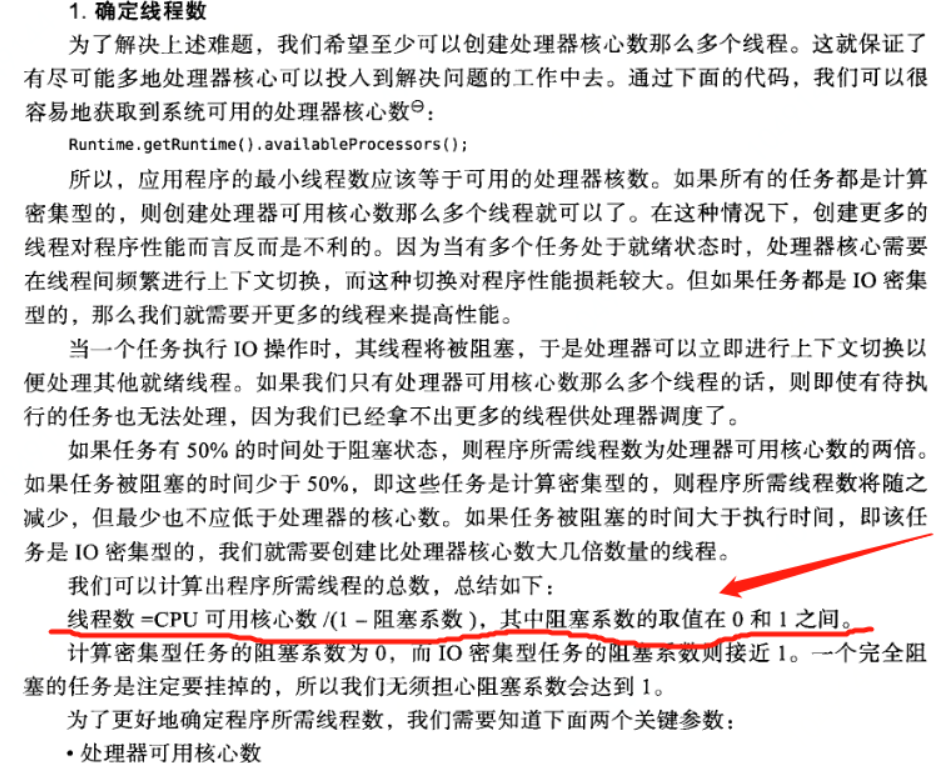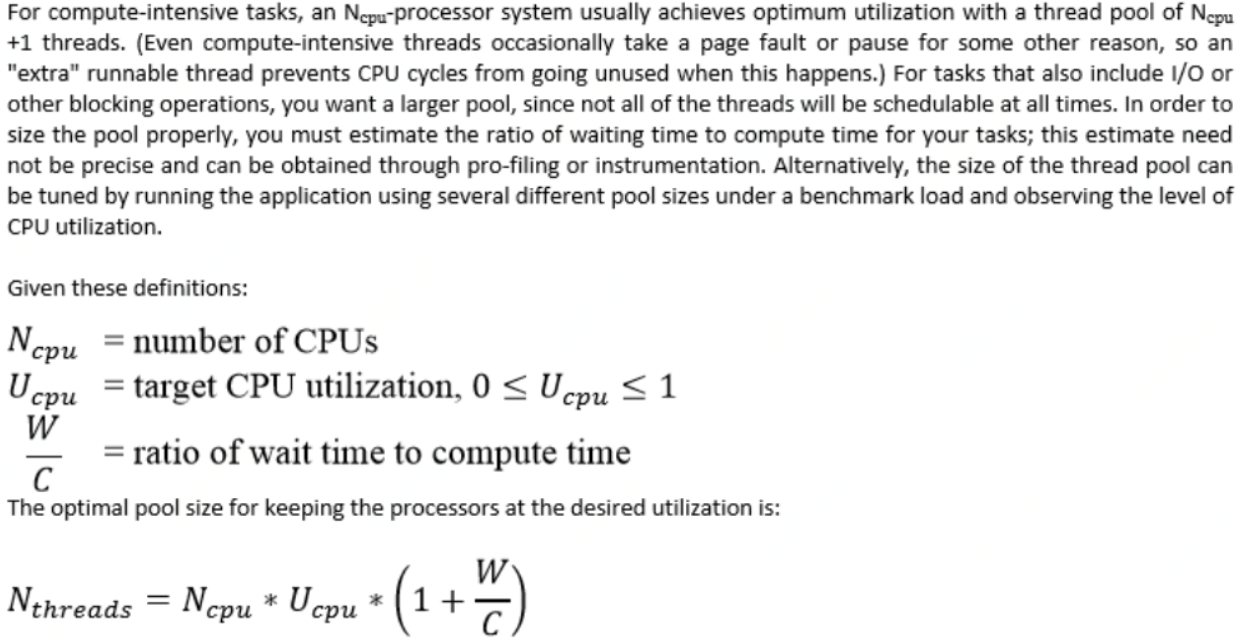------基于异步优化与 MyBatis-Plus 分页插件思想的实践
适用场景
- 数据量较大的单表分页查询
- 较复杂的多表关联查询,包含group by等无法进行count优化较耗时的分页查询
技术栈
-
核心框架:Spring Boot + MyBatis-Plus
-
异步编程:JDK 8+ 的
CompletableFuture -
数据库:MySQL 8.0
-
线程池:自定义线程池管理并行任务(如
ThreadPoolTaskExecutor)
实现思路
解决传统分页查询中 串行执行 COUNT 与数据查询 的性能瓶颈,通过 并行化 减少总耗时,同时兼容复杂查询场景(如多表关联、DISTINCT 等)
兼容mybatisPlus分页参数,复用 IPage 接口定义分页参数(当前页、每页条数),
借鉴 MyBatis-Plus 的 PaginationInnerInterceptor,通过实现 MyBatis 的 Interceptor 接口,拦截 Executor#query 方法,动态修改 SQL,
sql优化适配:COUNT 优化:自动移除 ORDER BY,保留 GROUP BY 和 DISTINCT(需包裹子查询),数据查询:保留完整 SQL 逻辑,仅追加 LIMIT 和 OFFSET。
直接上代码
使用简单
调用查询方法前赋值page对象属性total大于0数值则可进入自定义分页查询方案。
//示例代码
Page<User> page = new Page<>(1,10);
page.setTotal(1L);线程池配置
@Configuration
public class ThreadPoolTaskExecutorConfig {
public static final Integer CORE_POOL_SIZE = 20;
public static final Integer MAX_POOL_SIZE = 40;
public static final Integer QUEUE_CAPACITY = 200;
public static final Integer KEEP_ALIVE_SECONDS = 60;
@Bean("threadPoolTaskExecutor")
public ThreadPoolTaskExecutor getThreadPoolTaskExecutor() {
ThreadPoolTaskExecutor threadPoolTaskExecutor = new ThreadPoolTaskExecutor();
//核心线程数
threadPoolTaskExecutor.setCorePoolSize(CORE_POOL_SIZE);
//线程池最大线程数
threadPoolTaskExecutor.setMaxPoolSize(MAX_POOL_SIZE);
//队列容量
threadPoolTaskExecutor.setQueueCapacity(QUEUE_CAPACITY);
//线程空闲存活时间
threadPoolTaskExecutor.setKeepAliveSeconds(KEEP_ALIVE_SECONDS);
//线程前缀
threadPoolTaskExecutor.setThreadNamePrefix("commonTask-");
//拒绝策略
threadPoolTaskExecutor.setRejectedExecutionHandler(new ThreadPoolExecutor.CallerRunsPolicy());
//线程池初始化
threadPoolTaskExecutor.initialize();
return threadPoolTaskExecutor;
}
@Bean("countAsyncThreadPool")
public ThreadPoolTaskExecutor getCountAsyncThreadPool() {
ThreadPoolTaskExecutor threadPoolTaskExecutor = new ThreadPoolTaskExecutor();
//核心线程数,根据负载动态调整
threadPoolTaskExecutor.setCorePoolSize(6);
//线程池最大线程数,根据负载动态调整
threadPoolTaskExecutor.setMaxPoolSize(12);
//队列容量 队列容量不宜过多,根据负载动态调整
threadPoolTaskExecutor.setQueueCapacity(2);
//线程空闲存活时间
threadPoolTaskExecutor.setKeepAliveSeconds(KEEP_ALIVE_SECONDS);
//线程前缀
threadPoolTaskExecutor.setThreadNamePrefix("countAsync-");
//拒绝策略 队列满时由调用者主线程执行
threadPoolTaskExecutor.setRejectedExecutionHandler(new ThreadPoolExecutor.CallerRunsPolicy());
//线程池初始化
threadPoolTaskExecutor.initialize();
return threadPoolTaskExecutor;
}
}mybatis-plus配置类
@Configuration
@MapperScan("com.xxx.mapper")
public class MybatisPlusConfig {
@Resource
ThreadPoolTaskExecutor countAsyncThreadPool;
@Resource
ApplicationContext applicationContext;
@Bean
public MybatisPlusInterceptor mybatisPlusInterceptor() {
MybatisPlusInterceptor interceptor = new MybatisPlusInterceptor();
interceptor.addInnerInterceptor(new PaginationInnerInterceptor(DbType.MYSQL));
return interceptor;
}
@Bean
public PageParallelQueryInterceptor pageParallelQueryInterceptor() {
PageParallelQueryInterceptor pageParallelQueryInterceptor = new PageParallelQueryInterceptor();
pageParallelQueryInterceptor.setCountAsyncThreadPool(countAsyncThreadPool);
pageParallelQueryInterceptor.setApplicationContext(applicationContext);
return pageParallelQueryInterceptor;
}
}自定义mybatis拦截器
package com.example.dlock_demo.interceptor;
import com.baomidou.mybatisplus.core.toolkit.CollectionUtils;
import com.baomidou.mybatisplus.extension.plugins.pagination.Page;
import lombok.extern.slf4j.Slf4j;
import net.sf.jsqlparser.JSQLParserException;
import net.sf.jsqlparser.expression.Expression;
import net.sf.jsqlparser.parser.CCJSqlParserUtil;
import net.sf.jsqlparser.statement.select.*;
import org.apache.ibatis.builder.StaticSqlSource;
import org.apache.ibatis.cache.CacheKey;
import org.apache.ibatis.executor.Executor;
import org.apache.ibatis.mapping.BoundSql;
import org.apache.ibatis.mapping.MappedStatement;
import org.apache.ibatis.mapping.ResultMap;
import org.apache.ibatis.plugin.Interceptor;
import org.apache.ibatis.plugin.Intercepts;
import org.apache.ibatis.plugin.Invocation;
import org.apache.ibatis.plugin.Signature;
import org.apache.ibatis.session.*;
import org.springframework.context.ApplicationContext;
import org.springframework.scheduling.concurrent.ThreadPoolTaskExecutor;
import java.lang.reflect.Field;
import java.lang.reflect.Method;
import java.sql.SQLException;
import java.util.*;
import java.util.concurrent.CompletableFuture;
import java.util.concurrent.CompletionException;
import java.util.concurrent.ConcurrentHashMap;
/**
* Mybatis-分页并行查询拦截器
*
* @author shf
*/
@Intercepts({
@Signature(type = Executor.class, method = "query",
args = {MappedStatement.class, Object.class, RowBounds.class, ResultHandler.class}),
@Signature(type = Executor.class, method = "query",
args = {MappedStatement.class, Object.class, RowBounds.class, ResultHandler.class, CacheKey.class, BoundSql.class})
})
@Slf4j
public class PageParallelQueryInterceptor implements Interceptor {
/**
* 用于数据库并行查询线程池
*/
private ThreadPoolTaskExecutor countAsyncThreadPool;
/**
* 容器上下文
*/
private ApplicationContext applicationContext;
private static final String LONG_RESULT_MAP_ID = "twoPhase-Long-ResultMap";
private static final Map<String, MappedStatement> twoPhaseMsCache = new ConcurrentHashMap();
public void setCountAsyncThreadPool(ThreadPoolTaskExecutor countAsyncThreadPool) {
this.countAsyncThreadPool = countAsyncThreadPool;
}
public void setApplicationContext(ApplicationContext applicationContext) {
this.applicationContext = applicationContext;
}
@Override
public Object intercept(Invocation invocation) throws Throwable {
Object[] args = invocation.getArgs();
MappedStatement ms = (MappedStatement) args[0];
Object parameter = args[1];
//获取分页参数
Page<?> page = getPageParameter(parameter);
if (page == null || page.getSize() <= 0 || !page.searchCount() || page.getTotal() == 0) {
return invocation.proceed();
}
//获取Mapper方法(注解形式 需利用反射且只能应用在mapper接口层,不推荐使用)
/*Method method = getMapperMethod(ms);
if (method == null || !method.isAnnotationPresent(PageParallelQuery.class)) {
return invocation.proceed();
}*/
BoundSql boundSql = ms.getBoundSql(parameter);
String originalSql = boundSql.getSql();
//禁用mybatis plus PaginationInnerInterceptor count查询
page.setSearchCount(false);
page.setTotal(0);
args[2] = RowBounds.DEFAULT;
CompletableFuture<Long> countFuture = resolveCountCompletableFuture(invocation, originalSql);
//limit查询
long startTime = System.currentTimeMillis();
Object proceed = invocation.proceed();
log.info("原SQL数据查询-耗时={}", System.currentTimeMillis() - startTime);
page.setTotal(countFuture.get());
return proceed;
}
private CompletableFuture<Long> resolveCountCompletableFuture(Invocation invocation, String originalSql) {
return CompletableFuture.supplyAsync(() -> {
try {
//查询总条数
long startTime = System.currentTimeMillis();
long total = executeCountQuery(originalSql, invocation);
log.info("分页并行查询COUNT总条数[{}]-耗时={}", total, System.currentTimeMillis() - startTime);
return total;
} catch (Throwable e) {
log.error("page parallel query exception:", e);
throw new CompletionException(e);
}
}, countAsyncThreadPool).exceptionally(throwable -> {
log.error("page parallel query exception:", throwable);
return 0L;
});
}
private CompletableFuture<Object> resolveOriginalProceedCompletableFuture(Invocation invocation) {
return CompletableFuture.supplyAsync(() -> {
try {
long startTime = System.currentTimeMillis();
Object proceed = invocation.proceed();
log.info("原SQL数据查询-耗时={}", System.currentTimeMillis() - startTime);
return proceed;
} catch (Throwable e) {
throw new CompletionException(e);
}
}, countAsyncThreadPool).exceptionally(throwable -> {
log.error("page parallel query original proceed exception:", throwable);
return null;
});
}
/**
* 执行count查询
*/
private long executeCountQuery(String originalSql, Invocation invocation)
throws JSQLParserException, SQLException {
//解析并修改SQL为count查询
Select countSelect = (Select) CCJSqlParserUtil.parse(originalSql);
PlainSelect plainSelect = (PlainSelect) countSelect.getSelectBody();
//修改select为count(*)
/*plainSelect.setSelectItems(Collections.singletonList(
new SelectExpressionItem(new Function("COUNT", new Column("*")))
);*/
// 移除排序和分页
Distinct distinct = plainSelect.getDistinct();
GroupByElement groupBy = plainSelect.getGroupBy();
String countSql = "";
if (groupBy == null && distinct == null) {
Expression countFuncExpression = CCJSqlParserUtil.parseExpression("COUNT(*)");
plainSelect.setSelectItems(Collections.singletonList(
new SelectExpressionItem(countFuncExpression)));
plainSelect.setOrderByElements(null);
countSql = plainSelect.toString();
} else if (groupBy != null) {
plainSelect.setLimit(null);
plainSelect.setOffset(null);
countSql = "SELECT COUNT(*) FROM (" + plainSelect + ") TOTAL";
} else {
plainSelect.setOrderByElements(null);
plainSelect.setLimit(null);
plainSelect.setOffset(null);
countSql = "SELECT COUNT(*) FROM (" + plainSelect + ") TOTAL";
}
//执行count查询
return doCountQuery(invocation, countSql);
}
/**
* 执行修改后的COUNT(*)-SQL查询
*/
@SuppressWarnings("unchecked")
private Long doCountQuery(Invocation invocation, String modifiedSql) {
//Executor executor = (Executor) invocation.getTarget();
//创建新会话(自动获取新连接)
Executor executor;
SqlSessionFactory sqlSessionFactory = applicationContext.getBean(SqlSessionFactory.class);
try (SqlSession sqlSession = sqlSessionFactory.openSession(ExecutorType.SIMPLE)) {
//com.alibaba.druid.pool.DruidPooledConnection
System.out.println("新会话Connection class: " + sqlSession.getConnection().getClass().getName());
Field executorField = sqlSession.getClass().getDeclaredField("executor");
executorField.setAccessible(true);
executor = (Executor) executorField.get(sqlSession);
Object[] args = invocation.getArgs();
MappedStatement originalMs = (MappedStatement) args[0];
Object parameter = args[1];
//创建新的查询参数
Map<String, Object> newParameter = new HashMap<>();
if (parameter instanceof Map) {
// 复制原始参数但移除分页参数
Map<?, ?> originalParams = (Map<?, ?>) parameter;
originalParams.forEach((k, v) -> {
if (!(v instanceof Page)) {
newParameter.put(k.toString(), v);
}
});
}
//创建新的BoundSql
BoundSql originalBoundSql = originalMs.getBoundSql(newParameter);
BoundSql newBoundSql = new BoundSql(originalMs.getConfiguration(), modifiedSql, originalBoundSql.getParameterMappings(), newParameter);
//复制原始参数值
originalBoundSql.getParameterMappings().forEach(mapping -> {
String prop = mapping.getProperty();
if (mapping.getJavaType().isInstance(newParameter)) {
newBoundSql.setAdditionalParameter(prop, newParameter);
} else if (newParameter instanceof Map) {
Object value = ((Map<?, ?>) newParameter).get(prop);
newBoundSql.setAdditionalParameter(prop, value);
}
});
//创建新的BoundSql
/*BoundSql originalBoundSql = originalMs.getBoundSql(parameter);
BoundSql newBoundSql = new BoundSql(originalMs.getConfiguration(), modifiedSql,
originalBoundSql.getParameterMappings(), parameter);*/
Configuration configuration = originalMs.getConfiguration();
//创建临时ResultMap
ResultMap resultMap = new ResultMap.Builder(
configuration,
LONG_RESULT_MAP_ID,
//强制指定结果类型
Long.class,
//自动映射列到简单类型
Collections.emptyList()
).build();
if (!configuration.hasResultMap(LONG_RESULT_MAP_ID)) {
configuration.addResultMap(resultMap);
}
String countMsId = originalMs.getId() + "_countMsId";
MappedStatement mappedStatement = twoPhaseMsCache.computeIfAbsent(countMsId, (key) ->
this.getNewMappedStatement(modifiedSql, originalMs, newBoundSql, resultMap, countMsId));
//执行查询
List<Object> result = executor.query(mappedStatement, newParameter, RowBounds.DEFAULT, (ResultHandler<?>) args[3]);
long total = 0L;
if (CollectionUtils.isNotEmpty(result)) {
Object o = result.get(0);
if (o != null) {
total = Long.parseLong(o.toString());
}
}
return total;
} catch (Throwable e) {
log.error("分页并行查询-executeCountQuery异常:", e);
}
return 0L;
}
private MappedStatement getNewMappedStatement(String modifiedSql, MappedStatement originalMs, BoundSql newBoundSql,
ResultMap resultMap, String msId) {
//创建新的MappedStatement
MappedStatement.Builder builder = new MappedStatement.Builder(
originalMs.getConfiguration(),
msId,
new StaticSqlSource(originalMs.getConfiguration(), modifiedSql, newBoundSql.getParameterMappings()),
originalMs.getSqlCommandType()
);
//复制重要属性
builder.resource(originalMs.getResource())
.fetchSize(originalMs.getFetchSize())
.timeout(originalMs.getTimeout())
.statementType(originalMs.getStatementType())
.keyGenerator(originalMs.getKeyGenerator())
.keyProperty(originalMs.getKeyProperties() == null ? null : String.join(",", originalMs.getKeyProperties()))
.resultMaps(resultMap == null ? originalMs.getResultMaps() : Collections.singletonList(resultMap))
.parameterMap(originalMs.getParameterMap())
.resultSetType(originalMs.getResultSetType())
.cache(originalMs.getCache())
.flushCacheRequired(originalMs.isFlushCacheRequired())
.useCache(originalMs.isUseCache());
return builder.build();
}
/**
* 获取分页参数
*/
private Page<?> getPageParameter(Object parameter) {
if (parameter instanceof Map) {
Map<?, ?> paramMap = (Map<?, ?>) parameter;
return (Page<?>) paramMap.values().stream()
.filter(p -> p instanceof Page)
.findFirst()
.orElse(null);
}
return parameter instanceof Page ? (Page<?>) parameter : null;
}
/**
* 获取Mapper方法
*/
private Method getMapperMethod(MappedStatement ms) {
try {
String methodName = ms.getId().substring(ms.getId().lastIndexOf(".") + 1);
Class<?> mapperClass = Class.forName(ms.getId().substring(0, ms.getId().lastIndexOf(".")));
return Arrays.stream(mapperClass.getMethods())
.filter(m -> m.getName().equals(methodName))
.findFirst()
.orElse(null);
} catch (ClassNotFoundException e) {
return null;
}
}
}注意事项
有人可能会担心并行查询,在高并发场景可能会导致count查询与limit数据查询不一致,但其实只要没有锁,只要是分开的两条sql查询,原mybatisplus分页插件也一样面临这个问题。
count优化没有进行join语句判断优化,相当于主动关闭了page.setOptimizeJoinOfCountSql(false);在一对多等场景可能会造成count查询有误,Mybatisplus官网也有相关提示,所以这里干脆舍弃了。
mybatisplus版本不同,可能会导致JsqlParser所使用的api有所不同,需要自己对应版本修改下。本篇版本使用的3.5.1
关于线程池的线程数设置顺便提一下:
网上流行一个说法:
- CPU 密集型任务
特点:任务主要消耗 CPU 资源(如复杂计算、图像处理)。
线程数建议:
- 核心线程数:CPU 核心数 + 1(或等于CPU核心数,避免上下文切换过多)。
- 最大线程数:与核心线程数相同(防止过多线程竞争 CPU)。
- I/O 密集型任务
特点:任务涉及大量等待(如网络请求、数据库读写)。
线程数建议:
- 核心线程数:2 * CPU 核心数(确保正常负载下的高效处理)。
- 最大线程数:根据系统资源调整(用于应对突发高并发)。
其实这个说法来源于一个经验公式推导而来:
threads = CPU核心数 * (1 + 平均等待时间 / 平均计算时间)
《Java 虚拟机并发编程》中介绍


另一篇:《Java Concurrency in Practice》即《java并发编程实践》,给出的线程池大小的估算公式:

Nthreads=Ncpu*Ucpu*(1+w/c),其中 Ncpu=CPU核心数,Ucpu=cpu使用率,0~1;W/C=等待时间与计算时间的比率
仔细推导两个公式,其实类似,在cpu使用率达100%时,其实结论是一致的,这时候计算线程数的公式就成了,Nthreads=Ncpu*100%*(1+w/c) =Ncpu*(1+w/c)。
那么在实践应用中计算的公式就出来了,【以下推算,不考虑内存消耗等方面】,如下:
1、针对IO密集型,阻塞耗时w一般都是计算耗时几倍c,假设阻塞耗时=计算耗时的情况下,Nthreads=Ncpu*(1+1)=2Ncpu,所以这种情况下,建议考虑2倍的CPU核心数做为线程数
2、对于计算密集型,阻塞耗时趋于0,即w/c趋于0,公式Nthreads = Ncpu。
实际应用时要考虑同时设置了几个隔离线程池,另外tomcat自带的线程池也会共享宿主机公共资源。